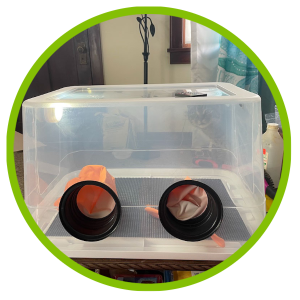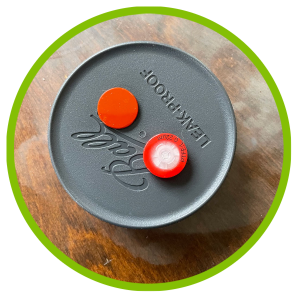Contamination
Contamination
Contamination is defined as anything in your culture other than the mushroom you’re trying to grow. It’s most commonly a mold, green or brown, that grows quickly enough to crowd out the fungus. This is a problem and there are entirely too many sources: air, water, surfaces, hands, breath. Look around your work space and consider how many microorganisms can potentially invade and ruin your project.
Stamets Identifies Six Vectors of Contamination
- cultivator (you)
- air
- media
- tools
- inoculum
- mobile contamination units (MCUs), ie insects such as mites that love fungi, and even children running through the work area.
Aseptic Technique
This is one tool in the anti-contamination arsenal. Even if you have a clean room in your house, this will be mandatory. Aseptic technique involves sterilizing, with bleach, alcohol, and fire. Mild bleach solutions or isopropyl alcohol are used for cleaning surfaces such as tables and the inside of a still air box. Either can be used to clean hands, including gloved hands, several times throughout a given procedure. Alcohol and a lighter works well to flame needles before inoculation of plates or jars, but do remember that alcohol is quite flammable so be careful! This is why a bleach solution is beneficial. There is no such thing as too clean! This may seem like a hassle, but it’s far easier than tossing grain jars, sawdust or straw blocks, or plates. Good technique can save several weeks of work and much heartache.
Still Air Box

Still Air Box
This is a clear box with holes for gloved hands to work inside. They can be purchased or made, and are well worth the effort. This will provide a clean space for inoculating cultures, whether you’re working with jars, bags, or plates. The box is cleaned thoroughly before use and between procedures with either bleach or alcohol. Have your supplies prepared for your procedure and clean everything, then place your supplies in the box and seal the lid. There’s usually a small hole in the top to spritz some cleaner into, for disinfecting the air within the box. I clean every single item I plan to use down to jar lids and rubber bands or twist ties. The box will help keep air contamination from your cultures.
Instructions for making a still air box can easily be found on the web and YouTube. If you’re buying, be aware that shipping fees can be stiff due to the size of the box. Buy (or get made) close to home if possible.
Mycology Lids

Mycology Lids
These consist of a lid with a filter and a self-healing port usually made of sealant or a rubber stop. They can be made very easily but honestly, the lids I made yielded a 50% (4 of 8 jars) contamination rate vs. 17% (1 of 6 jars) from those I purchased. Part of the problem might have been the lack of a self-healing port in those I made; I didn’t have any sealant in house at the time, so I injected past the cotton stopper and might well have introduced contamination that way. Synthetic filter material might also have been a better choice. The lids I purchased are reusable.
Lamellar flow hoods keep a clean stream of air flowing in your workspace but can be horribly expensive, anywhere from $500-$1200 as of this writing. They can certainly be made with a bit of skill, but for the hobby grower a still air box is much easier and when used correctly, very effective. Ditto the autoclave: wonderful tool if you can use it, but not easily amenable to the home growing environment. However, if you’re considering getting into commercial growing, these items are worth consideration.
A “Clean Room” is a Nice Thing to Have if You Can
 A Clean Room is a work space dedicated to mushroom growing, ideally close to the kitchen so you’re not walking your freshly sterilized substrates too far through contamination-infested areas. Clean rooms should be isolated, with limited air flow and no carpet to house millions of spores, all waiting to contaminate your precious cultures.
A Clean Room is a work space dedicated to mushroom growing, ideally close to the kitchen so you’re not walking your freshly sterilized substrates too far through contamination-infested areas. Clean rooms should be isolated, with limited air flow and no carpet to house millions of spores, all waiting to contaminate your precious cultures.
Lacking these fancy gadgets doesn’t mean you can’t do everything possible to prevent contamination. I don’t have a clean room, lamellar flow hood, or autoclave. My work space is carpeted and close to a heat vent. This is where the still air box and aseptic technique prove their value. Scrub your person and your hands like you’re a doctor going into surgery. Clean clothes and a mask can help. Have everything needed for your procedure prepared in advance and sterilize everything you put into your box before closing.
I leave my sterilized sawdust blocks sealed in my pressure canner until I’m ready to inoculate them, open them in the still air box only long enough to do what I need to do, then close them right away. My box is only big enough to fit one block or bag at a time, so I sterilize between procedures as well. I do the same when I’m subculturing spawn: sterilize both jar and lid before going into the box, open only long enough to do the job, then close right away. This has been helpful not only to prevent contamination, but spills as well. My box is a bit small and as I’ve said above, they’re kind of a pain to work inside of. I’ve knocked jars over, and would have inoculum spilled all over if I hadn’t closed the jar when done.
Summary
Contamination comes from many sources: air, insects, even yourself. I can’t recommend aseptic techniques and proper equipment strongly enough! There’s nothing more heart-breaking than losing several weeks worth of effort and supplies to it. So be calm, be clean, and enjoy the fruits of your labor for years to come!

